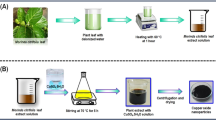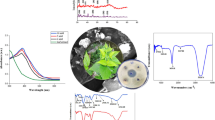Abstract
The present study was reported with synthesize of copper oxide nanoparticles by ethno botanical species. Bio convivial and compatible approaches were made to utilize the renewable source of leaves extract of Achyranthes aspera Linn as efficient capping and stabilizing agent as well. Also, natural A. aspera was functioned as reductant in the formation of CuO NPs. The phytosynthesized CuO nanoparticles were extensively characterized by X-ray diffraction analysis, Fourier transform infrared spectroscopy, Scanning electron microscopy, Energy dispersive X-ray diffraction, High resolution tunnelling electron microscopy and also comprehensively examined their biological applications like antibacterial and antifungal susceptibility against E. lenta, E. aerogenes and C. albicans strains. An XRD result of prepared CuO nanoparticles reveals the monoclinic crystalline structure and average crystallite size of 11–16 nm. The morphology variations for different concentrations of precursor material were noticed by SEM image. Furthermore, the crystalline planes found in SAED pattern of synthesized CuO NPs were coincide to the analysed XRD spectra. In the present study, a novel green approach was used to synthesize of CuO NPs for the antibacterial activity of poorly characterized and emerging pathogens of E. lenta and E. aerogenes. Further, the physicochemical, morphological and biological properties of CuO NPs are discussed.








Similar content being viewed by others
References
W. Wang, L. Susan, Z. Yuhe, L. Ming, Z. Qian, and F. Yating (2015). J. Nanomater. 01, 11.
J. Mathew, J. Josn, and G. Soney (2018). J. King Saud Univ. Sci. 01, 09.
R. Lav Khot, S. Sindhuja, J. M. Maja, E. Reza, W. Edmund, and W. Schuster (2012). J. Crop Prot. 64, 70.
L. E. Bradley, C. Laurence, and C. Qasim (2011). Trends Food Sci. Technol. 22, 604.
G. Mandal and T. Ganguly (2011). Indian J. Phys. 8, 1229.
S. Guobin, S. Yan, R. D. Tyagi Rao, Y. Surampalli, Tian, and C. Zhang (2009). Pract. Period. Hazard. Toxic Radioact. Waste Manage. 13, 110.
C. Aicheng and C. Sanghamitra (2013). Chem. Soc. Rev. 42, 5425.
W. Xiangjian, H. Yi, and C. Yongsheng (2012). Acc. Chem. Res. 45, 598.
B. Niranjan, M. Sarkar, M. Maiti, P. Nandy, R. Basu, and S. Das (2017). New J. Chem. 41, 4458.
V. K. Patel (2013). J. Clust. Sci. 24, 821.
V. K. Patel and S. Bhattacharya (2013). ACS Appl. Mater. Interfaces 5, 13364.
A. Antony, D. Subramanian, H. Moon-Soo, and M. Y. Sun (2014). Chem. Eng. 14, 1385.
S. Jagpreet, G. Kaur, and R. Mohit (2016). J. Bioelectron. Nanotechnol. 1, 01.
A. S. Zoolfakar, R. A. Rani, A. J. Morfa, A. P. Oullaned, and K. Kourosh (2014). J. Mater. Chem. 2, 5247.
M. Jitendra, B. Amla, S. Abhijeet, and M. Mohan Sharma (2014). Adv. Nat. Sci. Nanosci. Nanotechnol. 5, 01.
V. V. Makarov, A. J. Love, O. V. Sinitsyna, S. S. Makarova, I. V. Yaminsky, M. E. Taliansky, and N. O. Kalinina (2014). Acta Nat. 6, 35.
C. L. Priya, G. Kumar, L. Karthik, and K. V. Bhaskara Rao (2012). J. Agric. Sci. Tech.-Iran 8, (1), 143.
A. D. Regli and P. Marie (2015). J. Front. Microbiol. 6, 392.
M. S. Donnenberg, Enterobacteriaceae, 220.
B. J. Gardiner, A. Y. Tai, D. Kotsanas, M. J. Francis, S. A. Roberts, S. A. Ballard, R. K. Junckerstorff, and T. M. Kormana (2015). J. Clin. Microbiol. 53, 626.
C. W. Bok and Y. S. Ng (2009). Singap. Med. J. 12, 01.
M. R. Elias, Y. K. Shiao, J. Pupaibool, N. Ju-Hsien and W. Nathan (2012). Case Rep Med 01.
M. Abdallah, C. Jacqueline, D. R. Anne, B. Jacques, and P. Jean-Marie (2006). Curr. Drug Targets 7, 843.
S. Muthamil and K. P. Shunmugiah (2016). Biologia 71, 256.
A. Sajjad, A. Kashif, H. Zahid, S. K. Muhammad, M. K. Wisal, W. Sher, and S. Muhammad (2017). Pure Appl. Biol. 6, 418.
W. Shibeshi, E. Makonnen, A. Debella, and L. Zerihun (2006). Pharmacology 3, 217.
V. Sharma, A. Agarwal, U. Chaudhary, and M. Singh (2013). Int. J. Pharm. Pharm. Sci. 5, 317.
M. Rai and C. Posten (2013). Emma McCann, Green biosynthesis of nanoparticles: mechanisms and applications, pp 124–129.
A. Applerot, L. Jonathan, L. Anat, N. Yeshayahu, L. Rachel, G. Aharon, and B. Ehud (2012). Small 01, 13.
J. K. Sharma, M. S. Akhtar, S. Ameen, P. Srivastava, and G. Singh (2015). J. Alloys Compd. 632, 321.
B. K. Sharma, D. V. Shah, and D. R. Roy (2018). Mater. Res. Express 5, 095033.
P. P. N. Vijay Kumar, U. Shameem, P. Kollu, R. L. Kalyani, and S. V. N. Pammi (2015). BioNanoScience 5, 135.
V. V. Thekkae Padil and M. Černik (2013). Int. J. Nanomed. 8, 889.
J. Sunita, G. Suresh, N. Madhav, and R. Anjali (2011). J. Clust. Sci. 22, 121–129.
A. Azam, A. S. Ahmed, M. Oves, M. S. Khan, and A. Memic (2012). Int. J. Nanomed. 7, 6003–6009.
D. Devipriya and S. Mohana Roopan (2017). Mater. Sci. Eng. C 80, 38.
C. L. Santos, A. J. R. Albuquerque, F. C. Sampaio, and D. Keyson (2013). Int. J. Sci. Technol. Educ. Res. 1, 143.
K. Peter and S. Ratnasamy (2010). J. Nanosci. Nanotechnol. 10, 12.
C. Ya-Nan, Z. Mingyi, X. Lin, Z. Jun, and X. Gengmei (2012). Materials 5, 850.
W. Linlin, H. Chen, and S. Longquan (2017). Int. J. Nanomed. 12, 1227.
H. T. Singh, K. Dharambir, B. S. Kaur, K. Pardeep, G. Kumar, and S. Sardul (2015). Life Sci. 15, 30047.
Acknowledgements
The authors are grateful to Prof. R. Jayavel, Crystal Growth Centre, Anna University, Chennai, Tamil Nadu, India for enabling laboratory facilities.
Author information
Authors and Affiliations
Corresponding author
Additional information
Publisher's Note
Springer Nature remains neutral with regard to jurisdictional claims in published maps and institutional affiliations.
Rights and permissions
About this article
Cite this article
Pavithra, S., Mohana, B., Mani, M. et al. Physicochemical and Morphological Properties of Achyranthes aspera Mediated CuO Nanoparticles for Inhibiting Cellular Adhesion. J Clust Sci 32, 379–389 (2021). https://doi.org/10.1007/s10876-020-01796-6
Received:
Published:
Issue Date:
DOI: https://doi.org/10.1007/s10876-020-01796-6




